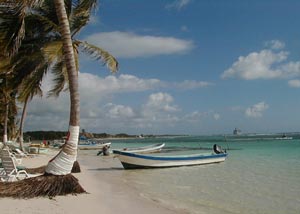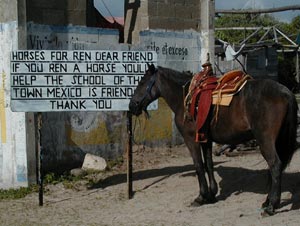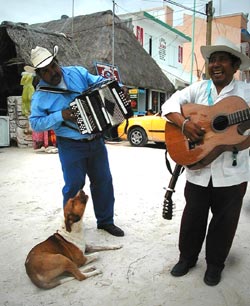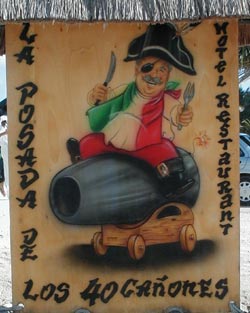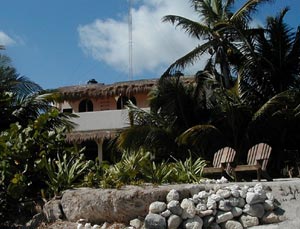|
From
my hotel room in the beach part of the town of Corozal I decided
to take a day trip across the Belize-Mexico borderline for a little
cultural exchange. At first I thought I would simply spend some
time in the Commercial Free Zone before heading for Mexico, but
when I discovered that tourist must officially depart Belize before
being allowed into the CFZ, I decided to make it a road trip as
opposed to a day trip.
Therefore, I spoke to my host at the wonderful Corozal Bay Inn who made a call to a local taxi driver to make arrangements for the border crossing. At the arranged time early the next morning, the cabbie picked me up in the parking lot at the Corozal Bay Inn at 7am. We then headed towards the Belize-Mexico border about fifteen minutes by car from downtown Corozal. Once we arrived to the Belizean customs and immigration building, I hopped out of the taxi and headed for the departure door. With my backpack left behind in the trunk of the taxi, I walk into the Belizean departure area where I was greeted by a lone Belizean immigration official. After a few moments of exchanging pleasantries and 37.5 Belize dollars from my purse to the GOB's (Government of Belize), the agent stamped my passport with the exit stamp and sent me to the customs official who reviewed the stamp, smiled and then pointed me towards the exit door. Back in the taxi, we then drove across the Rio Hondo River and bridge before the cab pulled over to the right curb just outside the Mexican immigration office. My friendly Belizean cabbie pointed me towards the door for visitors entering Mexico. Once again my backpack remained in the trunk of the taxi. |
In our case the color came up red and therefore signified that we were up for a closer inspection. However, and this is the honest truth, because the four Mexican soldiers were obviously involved with several plates of tacos that had just arrived to their location, we were simply waived on through despite the red stoplight and sent on our way. About one quarter of a mile down the road we were once again waived down and asked to pull into what appeared to be similar to a carwash. At this checkpoint the taxi driver was asked to go inside and make a payment of what I was told to be the equivalent of about five Belize dollars, more or less. While the taxi driver paid the cashier, two attendants spayed the undercarriage of the car. This we were told is necessary to protect the agriculture and citrus industry in Mexico. Good idea I guess, assuming that insects don't simply fly over the Rio Hondo into Mexico and vice versa. Completely cleared of all the required formalities from both the Belizean as well as the Mexican governments, my taxi driver then delivered me to my intended final destination, the Chetumal, Mexico bus station. Once there I paid the cab fare, removed my backpack from the trunk and then thanked my taxi driver for the smooth ride over from Belize. |
||||||
I
then walked over to what I have always considered the best part
of the Chetumal bus station, one of several taco stands that operate
there in the parking lot. I relaxed and took in the sights and
sounds of Mexico as I devoured six tacos for less than four Belize
dollars.
As my mouth continued to burn from the green hot sauce that I had doused the tacos with, I walked into the bus station and to a place in the queue to purchase my ticket for the onward journey. And here is where I faced probably the hardest decision of this particular road trip. For when you are standing in the Chetumal bus station as well as most bus stations across the Estados Unidos of Mexico, there are so many options it's hard to pick and choose. |
||||||
After
reviewing the destination placards hanging above the ticket seller's
window, where the traveler has choices from Palenque to Cancun
to Playa Del Carmen to Mexico City to Limones, I booked a seat
on the next bus departing for the Costa Maya village of Mahajual.
As the tacos began to do their damage, the announcement came over the loudspeaker that the bus to Mahajual was ready for departure. I presented my ticket to the bus attendant who also was in charge of checking my backpack into the storage bin for the journey. I really like the buses in Mexico because for each bag checked, you are presented a baggage ticket that is required to claim your bag at the end of your trip. This cuts down upon the theft of the travelers personnel belongings that is rampant from Nairobi to Istanbul to Jakarta to Dakar. In the old days and I'm now referring to less than ten years ago, buses as well as cars were stopped at spotty checkpoints manned by M-16 toting young Mexican soldiers that were looking for drugs, weapons or illegal aliens. These days, the checkpoints have moved from the main thoroughfare which links the southern city of Chetumal to Cancun to the side roads like the highway that connects tourist and traveling Mexicans to the Costa Maya towns of Mahajual and Xcalak. Once the adventure tourists make their way through a handful of simple checkpoints, Costa Maya unfolds as this explorer can attest to not only as a land of unspoiled beauty but also as a place where colorful characters literally come out of the woodwork. From cabaña hotels laced gracefully in thatch roofed isolation where the innkeepers offer yoga lessons and free Internet as they boldly market themselves as the largest providers of solar and wind power along Costa Maya. They do so though while they require that their guest find their own connections for lunch and dinner in a place where a rental car or a bike or a hitchhike are the only means of transport. |
||||||||||||
Luckily, real sustainability like food and conversation along the Costa Maya can only be found these days in the isolated stretches of the road south for Xacalak by exploration. Places like that provided by a young Dane and Brit couple who are raising their family only a few meters away from the sandy shoreline of the Caribbean. They even have the patrolling Mexican security forces stopping by for a cool beverage. |
||||||
They
call their less complicated paradise found, 'Travel In', and it
is truly an oasis that will be more difficult to locate via the
world wide web than it will ever be if you simply take the time
of getting off the local bus that stops by no more than twice
per day.
In fact, I stumbled upon the excellent pita pizzas served up day in and day out by the owners/chefs of the 'Travel In' when hunger called me in from the wilds after a full day of dodging the local cats in the bush that were coming in shoreline to cover their personal culinary needs. This they did by preying upon the local population of 'los perros'. I must readily admit that I saw Costa Maya with great clarity during my short visit through the handful of locals like the gringo brother refugees from El Salvador that I befriended. They looked like the front members of the rock band ZZ-Top and they even play music in a group as the 'Brother's Two'. You can also have a good time with wonderful Italians that see a real future beyond the Cruise Ship tourists that plague their paradise, like the partners at the 40 Canones Hotel, Bar & Restaurant, one of the very best homes of hospitality available in a land of changing times. |
||||||
In
the end, it's not about Yogi or solar panels but more about who
you meet along the way. It's about the real characters like the
young couple at the 'Traveler's In', the Italians at '40 Canones'
Hotel, Bar & Restaurant and the regular unpretentious people
like Big John. He's a beach golfer from Oregon who serves up ice
cold cervezas on his front porch with the love of his life. Big
John keeps on smiling despite the death threats and opposition
from the Mexican mafia to his ownership of some of the last remaining
pristine oceanfront between the Maya Riviera of Mexico and Nicaragua.
Big John says he'll survive the threats and intimidation. However,
what scares him are the cruise ships and the new breed of expats
with their million dollar solar farms. |
||||||





